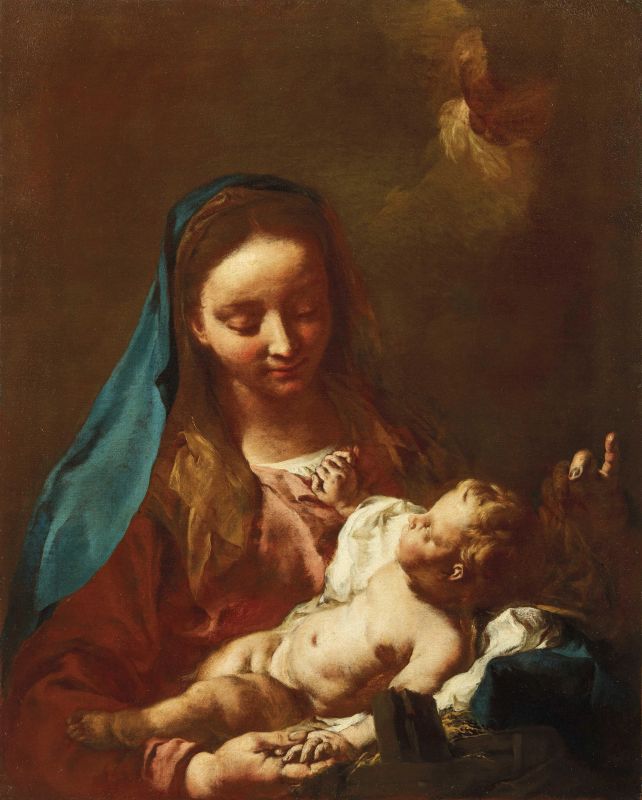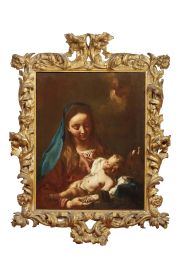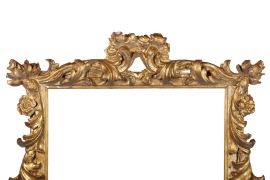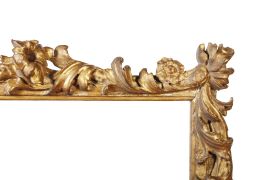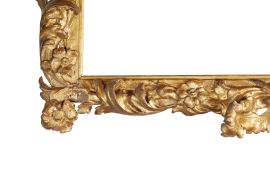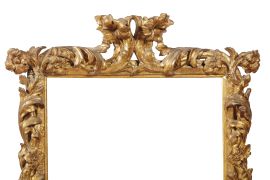Giovanni Battista Piazzetta
(Venice 1682-1754)
VIRGIN AND CHILD
oil on canvas, cm 77x61
An export license is available for this lot.
Provenance
(Lodovico Campo, Rovigo?)
Mario Viezzoli, Genua; private collection, Italy
Literature
(F. Bartoli, “Le Pitture Sculture ed Architetture della Città di Rovigo: con Indici ed Illustrazioni”, Venezia 1793, p. 101); R. Longhi, “Viatico per cinque secoli di pittura veneziana” (1946). 3rd edition, Firenze 1985, fig. 159 e p. 238; R. Pallucchini, “Piazzetta”, Milano 1956, p. 39 e fig. 93; R. Pallucchini, “Miscellanea piazzettesca”, in Arte Veneta XXII, 1968, p. 123; U. Ruggeri, “Francesco Capella detto Daggiù; dipinti e disegni”, Bergamo 1977, p. 174; L. Jones, “The Paintings of Giovan Battista Piazzetta”. Ph. D. Diss., New York University, 1981, II, p. 74, n. 21; III, fig. 106; R. Pallucchini, “L’opera completa del Piazzetta”. Apparati critici e filologici di A. Mariuz, Milano, Rizzoli, 1982, 140.
Hidden from view in an Italian private collection for more than half a century, this exceptionally fine painting was first published by Roberto Longhi in his celebrated review to the exhibition “Cinque secoli di pittura veneziana” (Five centuries of Painting in Venice) organized by Rodolfo Pallucchini and held in Venice soon after World War II.
Longhi’s essay referred to paintings shown in the exhibition, and was further illustrated through a selection of important works by the same artists, many of them previously unpublished.
Our painting, at the time in a private collection in Genua, was described by Longhi as coming from the Campo collection in Rovigo, where the18th century historian and connoisseur Francesco Bartoli had seen and recorded it in his guide of the city, printed in1793.
In the Campo palace near the church of the Trinità in Rovigo Bartoli describes in fact a painting by Piazzetta made for the nobleman Lodovico Campo and exactly matching ours: it depicted the Virgin with the Child lying in a simple crib (“Maria Vergine col suo Bambino sopra un povero letticello riposto”). A very famous painting, according to Bartoli, which had been copied by the nobleman Giovanni Campanari “for his own pleasure” (“per il suo proprio piacere”), the copy still hanging in the latter’s palace in the writer’s time.
As recorded in unpublished documents referred to by Franca Zava Boccazzi (“Pittoni. L’opera completa”, Venezia 1979, p. 158) a Madonna by Piazzetta is in fact specifically mentioned in the last will and testament of Lodovico Campo drawn up in 1766. During the 1740s Campo commissioned to Piazzetta a celebratory portrait of his ancestor, Count Gaspare Campo, the founder of the Accademia dei Concordi in Rovigo, as a gift to the Academy itself, which indirectly confirms a date around 1743 for our painting, as suggested by Rodolfo Pallucchini upon stylistic grounds.
Since publication by Pallucchini in 1956, our painting has been mentioned and reproduced in art-historical literature referring to Piazzetta. It was also mistakenly identified with a replica version which was in London with Sotheby’s in 1976 (8th December, lot 93) as the work of Francesco Capella, which suggested it was actually by Piazzetta’s workshop.
A third version known to us through a photograph with the Fondazione Cini, Venice, is certainly by the artist’s workshop. Its main difference from our painting and from the version formerly with Sotheby’s is an inventory number, 86, painted in oil, lower right; it doesn’t match any identified collection inventory, thus far.
Our painting was described by Pallucchini as marking the beginning of a new, classical phase in Piazzetta’s development in the early 1740s, with firmly outlined figures and stronger chiaroscuro contributing to balanced, somewhat academic compositions. It may be compared to other religious subjects painted for private patrons, such as St Anthony adoring the Christ Child (Zagreb, National Gallery) (see Pallucchini, 1956, fig. 92), and the Holy Family in a private collection (ibidem, fig. 94) from the same period.
Biographical notes
Giovan Battista Piazzetta was born in Venice in 1682, the son of a wood carver. He was first educated in his father’s workshop and in the workshop of little-known Silvestro Mainago. In 1697 he became a pupil of Antonio Molinari. He went to Bologna, where he studied the work of Giuseppe Crespi, and was back in Venice by 1711 when he enrolled in the “Fraglia” (professional guild) of painters.
Among his early public works, an altarpiece for the “Scuola dell’Angelo Custode” (Confraternity of the Guardian Angel) painted in 1717-18 should be mentioned, as well as “St. James’ Capture” for the church of San Stae, actually his youthful masterpiece, and “St. Dominic’s glory” for the church of SS. Giovanni e Paolo.
In 1727 he was offered membership of Accademia Clementina in Bologna, which proved his reputation was well established outside his native city. Piazzetta’s secular works were also famous and much sought after by private patrons, which prompted a very efficient workshop organization from the 1740s onwards.
Piazzetta also was a very fine and prolific draughtsman, as shown by his corpus of drawings and prints, many of them made as book illustrations from 1724 onwards.
Among his patrons, Marshal Matthias von Schulenburgh should be mentioned, a celebrated connoisseur to whom Giovan Battista Piazzetta was the artistic advisor from 1738 to 1745. He also painted for him thirteen works in oils and nineteen drawings.
In 1750 Piazzetta became the director of the “Scuola di Nudo” (School of Design after nude models) of the Venice painting Academy. He died in Venice in 1754.

